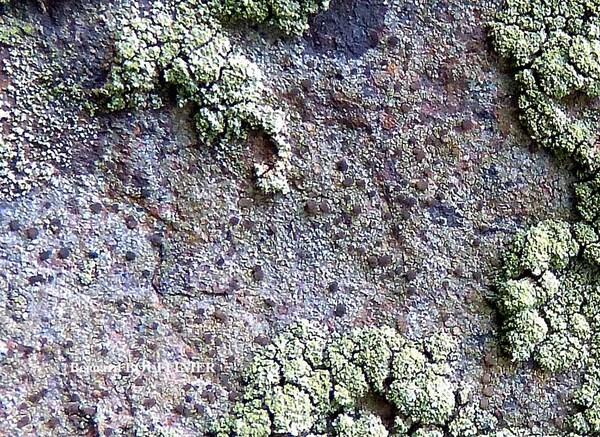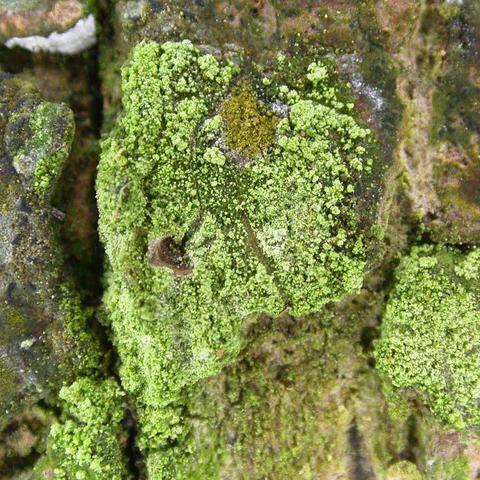Aquacidia viridifarinosa (Coppins & P. James) Aptroot
in Aptroot & al., Gorteria, 40: 13, 2018. Basionym: Bacidia viridifarinosa Coppins & P. James - Lichenologist, 24: 353, 1992.
Synonyms:
Distribution: S - Pugl (CLU 16671), Camp (Puntillo & Puntillo 2011), Cal (CLU 12774).
Description: Thallus crustose, episubstratic, bluish-green to grey-green, continuous to rimose, sorediate, often delimited by a whitish prothallus. Soredia punctiform or small-maculiform, at first well-delimited, then sometimes confluent, grey-green with a yellowish tinge, paler than thallus, the soredia farinose, 10-30(-40) µm thick. Apothecia extremely rare, pale orange-brown, lecideine, with a flat to finally convex disc and a paler, persistent proper margin. Proper exciple of thin-walled, branching hyphae; epithecium colourless to very pale yellow; hymenium and hypothecium colourless; paraphyses branched, with clavate apical cells. Asci 8-spored, cylindrical-clavate, with a K/I+ blue apical dome and an apical cushion surrounded by a cylindrical ring-structure, Micarea-type. Ascospores 6-8-septate, hyaline, fusiform-acicular, 33-44 x 3-4 μm. Pycnidia rather rare, whitish-pubescent, often with a gaping ostiole, 0.15-0.25 mm across. Conidia oblong, 4-6 x (1-)1.5 µm, biguttulate, often constricted in the middle. Photobiont chlorococcoid, the cells <10 µm wide. Spot tests: thallus K-, C-, KC-, P-, UV+ pink; pycnidia UV+ orange. Chemistry: xanthones (coronatone).Note: a suboceanic species growing on shaded, smooth and not too acid siliceous rocks in oceanic humid woodlands, sometimes on smooth bark at the base of old deciduous trees; mostly sterile and perhaps overlooked; the type material is from an old Tilia tree. The species belongs in the Pilocarpaceae.
Growth form: Crustose
Substrata: bark and rocks
Photobiont: green algae other than Trentepohlia
Reproductive strategy: mainly asexual, by soredia, or soredia-like structures (e.g. blastidia)
Most common in areas with a humid-warm climate (e.g. most of Tyrrenian Italy)
Commonnes-rarity: (info)
Alpine belt: absent
Subalpine belt: absent
Oromediterranean belt: absent
Montane belt: absent
Submediterranean belt: absent
Padanian area: absent
Humid submediterranean belt: extremely rare
Humid mediterranean belt: extremely rare
Dry mediterranean belt: absent

Predictive model
Herbarium samples
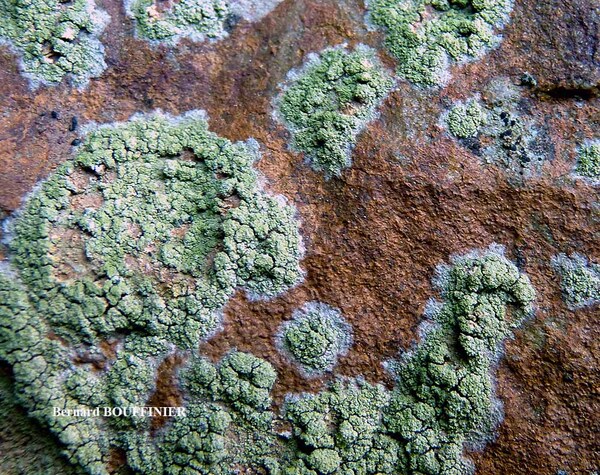
Bernard Bouffinier - Source: http://www.lichensmaritimes.org/index.php?task=fiche&lichen=738&lang=en
France, Le Loc'h
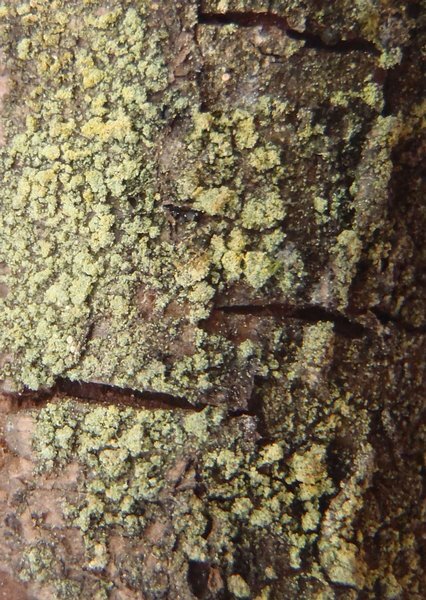

Curtis Randall Björk – CC BY-SA 4.0
British Columbia, Thompson Plateau, Opax Mountain Date: October, 2006 On rotting bark of Shepherdia in cool but dry forest in gully
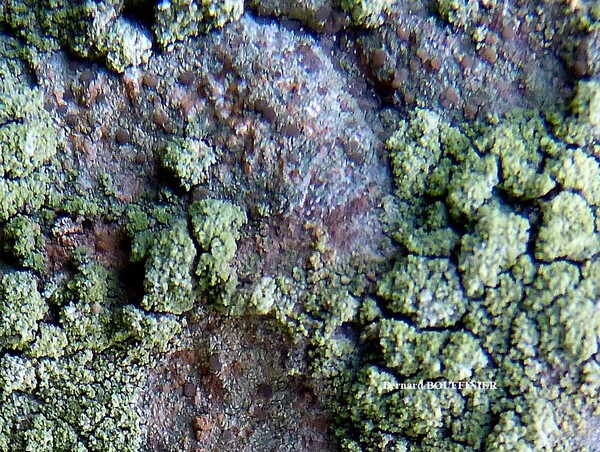
Bernard Bouffinier - Source: http://www.lichensmaritimes.org/index.php?task=fiche&lichen=738&lang=en
France, Le Loc'h
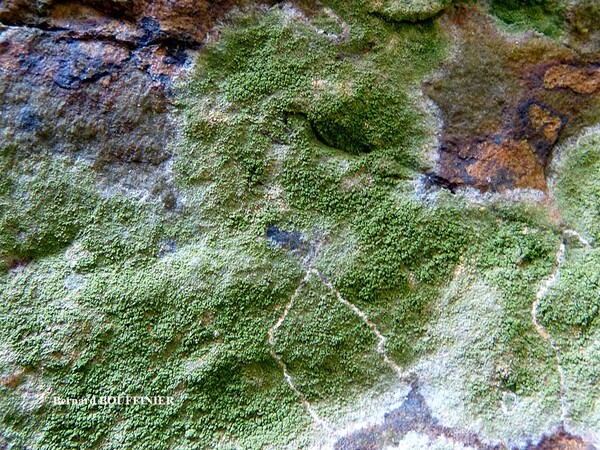
Bernard Bouffinier - Source: http://www.lichensmaritimes.org/index.php?task=fiche&lichen=738&lang=en
France, Le Loc'h
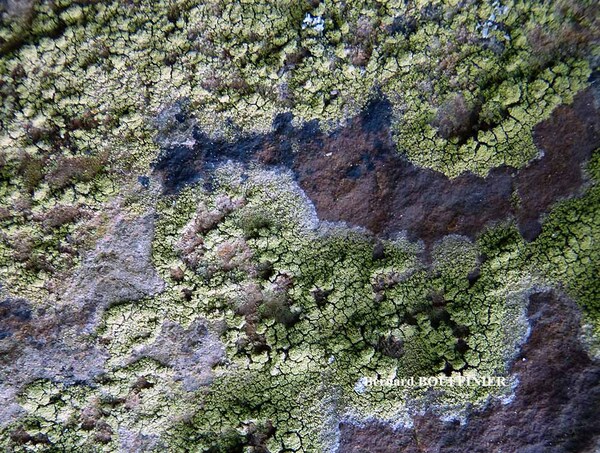
Bernard Bouffinier - Source: http://www.lichensmaritimes.org/index.php?task=fiche&lichen=738&lang=en
France, Le Loc'h
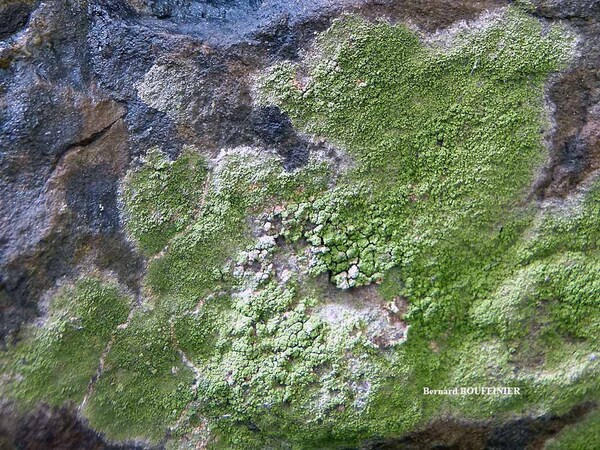
Bernard Bouffinier - Source: http://www.lichensmaritimes.org/index.php?task=fiche&lichen=738&lang=en
France, Le Loc'h
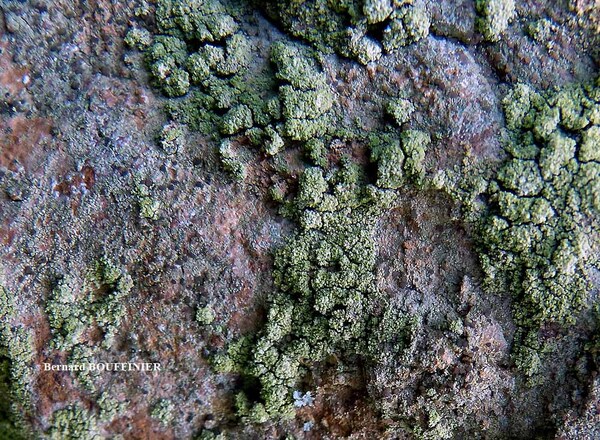
Bernard Bouffinier - Source: http://www.lichensmaritimes.org/index.php?task=fiche&lichen=738&lang=en
France, Le Loc'h
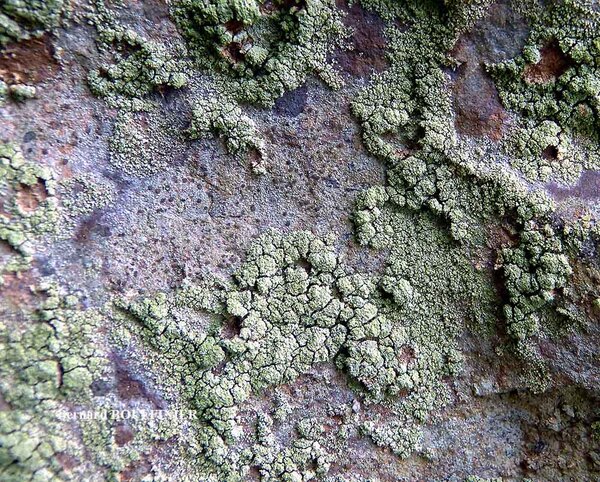
Bernard Bouffinier - Source: http://www.lichensmaritimes.org/index.php?task=fiche&lichen=738&lang=en
France, Le Loc'h
Growth form: Crustose
Substrata: bark and rocks
Photobiont: green algae other than Trentepohlia
Reproductive strategy: mainly asexual, by soredia, or soredia-like structures (e.g. blastidia)
Most common in areas with a humid-warm climate (e.g. most of Tyrrenian Italy)
Commonnes-rarity: (info)
Alpine belt: absent
Subalpine belt: absent
Oromediterranean belt: absent
Montane belt: absent
Submediterranean belt: absent
Padanian area: absent
Humid submediterranean belt: extremely rare
Humid mediterranean belt: extremely rare
Dry mediterranean belt: absent

Predictive model
| Herbarium samples |

Bernard Bouffinier - Source: http://www.lichensmaritimes.org/index.php?task=fiche&lichen=738&lang=en
France, Le Loc'h


Curtis Randall Björk – CC BY-SA 4.0
British Columbia, Thompson Plateau, Opax Mountain Date: October, 2006 On rotting bark of Shepherdia in cool but dry forest in gully

Bernard Bouffinier - Source: http://www.lichensmaritimes.org/index.php?task=fiche&lichen=738&lang=en
France, Le Loc'h

Bernard Bouffinier - Source: http://www.lichensmaritimes.org/index.php?task=fiche&lichen=738&lang=en
France, Le Loc'h

Bernard Bouffinier - Source: http://www.lichensmaritimes.org/index.php?task=fiche&lichen=738&lang=en
France, Le Loc'h

Bernard Bouffinier - Source: http://www.lichensmaritimes.org/index.php?task=fiche&lichen=738&lang=en
France, Le Loc'h

Bernard Bouffinier - Source: http://www.lichensmaritimes.org/index.php?task=fiche&lichen=738&lang=en
France, Le Loc'h

 Index Fungorum
Index Fungorum
 GBIF
GBIF
